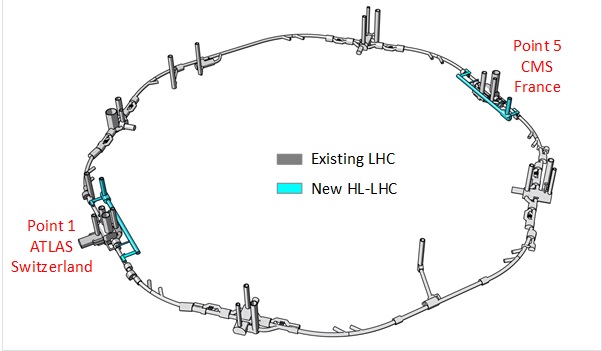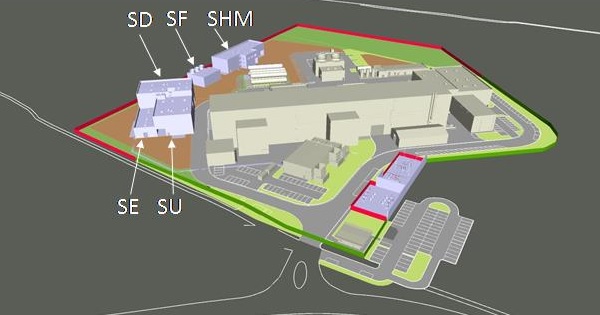![]() Civil engineering for the High-Luminosity LHC
Civil engineering for the High-Luminosity LHC
by Jean Laurent Tavian (CERN), Peter Mattelaer (CERN)
The High-Luminosity LHC (HL-LHC) project at CERN will require large infrastructures and services for the powering and the cooling of the high-field superconducting quadrupole magnets constituting the new inner triplets and of the superconducting RF crab-cavities used for the luminosity levelling. These new LHC accelerator components will be integrated at Point 1 and Point 5 of the LHC accelerator where the two large LHC detectors ATLAS and CMS are located (see Figure 1). These new infrastructures and services consist mainly of power transmission, electrical distribution, cooling, ventilation, cryogenics, power converters for superconducting magnets and inductive output tubes for superconducting RF cavities. To house all these new infrastructures and services, civil engineering structures are required including buildings, shaft, caverns and underground galleries.

Figure 1. Underground civil engineering of LHC (Image credit: CERN)
At ground level, the civil engineering consists of five buildings, technical galleries, access roads, concrete slabs and landscaping (See Figures 2 and 3). Per Point, the total surface corresponds to about 20’000 m2, including 3’300 m2 of buildings. A cluster of three buildings is located at the head of the shaft and will house the helium refrigerator cold-box (SD building), the water-cooling and ventilation units (SU building) as well as the main electrical distribution for high and low voltage (SE building). Two stand-alone buildings complete the inventory and will house the primary-water cooling towers (SF building) and the warm compressor station of the helium refrigerator (SHM building). Buildings housing noisy equipment (SU, SF, SHM) are built with noise-insulated concrete walls and roofs.

Figure 2. Point 1 ground-level civil engineering work (Image credit: CERN)

Figure 3. Point 5 ground-level civil engineering work (Image credit: CERN)
At underground level, the civil engineering work consist of a shaft, a service cavern, galleries, and vertical cores (See Figure 4). The total volume to be excavated corresponds to about 40’000 m3 per Point. The PM shaft (9.7-m diameter, 80-m height) will house a secured access lift and staircase as well as the services required at underground level. The service cavern (US/UW, 16-m diameter, 45-m long) will house cooling and ventilation units, a cryogenic box, an electrical safe room and electrical transformers. The UR gallery (5.8-m diameter, 300-m long) will house the power converters and electrical feed boxes for the superconducting magnets as well as cryogenic and service distribution. Two transversal UA galleries (6.2-m diameter, 50-m long) will house the RF equipment for the powering and controls of the superconducting crab-cavities. At the end of the UA galleries, evacuation galleries (UPR) are required for personnel emergency exits. Two transversal UL galleries (3-m diameter, 40-m long) will house the superconducting links powering the magnets and cryogenic distribution. Finally, the connection of the HL-LHC underground galleries to the LHC tunnel is made via 16 vertical cores (1-m diameter, 7-m long).

Figure 4. Underground civil-engineering work (Courtesy of LAP consortium)
The definition of the civil engineering for the HL-LHC has started in 2015. First integration studies have been performed in collaboration with the CERN SMB (Site Management and Buildings) Department, the equipment groups and the HL-LHC Project Office. In 2016, the completion of a preliminary study has allowed to issue a call for tender for two civil-engineering consultant contracts, which have been adjudicated in June 2016. These consultants are in charge of the preliminary, tender and construction design of the civil engineering works, as well as of the management of the construction including the defect liability. At Point 1 on the Swiss side, the consultant contract was adjudicated to a consortium, called ORIGIN, constituted of 3 companies: SETEC (FR) the consortium leader, CDS Engineers (CH) and Rocksoil (IT). At Point 5 on the French side, the consultant contract was adjudicated to a consortium, called LAP, constituted of 3 companies: Lombardi (CH) the consortium leader, Artelia (FR) and Pini Swiss (CH). In November 2016, the two consultants have completed the preliminary design phase including cost and construction-schedule estimates for the civil engineering work execution.
In parallel with the preliminary design, CERN, with the help of architects, has prepared the building permit applications which have been submitted to the Swiss and French Authorities in October and November 2016. Between 6 to 9 months will be required to get the building permit authorization, that is compatible with the start of the construction works scheduled by mid-2018. CERN has also performed geotechnical investigation in order to better identify the soil constituents. CERN has placed a contract with an independent engineer (Joint venture of ARUP (UK) and Geoconsult (AT)). This independent engineer will perform peer reviews of the consultant designs and will confirm that these designs have been performed with the appropriate skill, care and diligence in accordance with applicable standards. In addition, an adjudicator panel is constituted with lawyers, architects and civil engineers to resolve disputes in-between all parties.
The next important milestone will be the adjudication in March 2018 of the two contracts (one per Point) for the civil-engineering construction works. The tendering process has started with the issue of a market survey in December 2016 including relevant selection criteria requirements. It will be followed by calls for tenders, which will be sent to the qualified companies by June 2017. The main excavation works, producing harmful vibrations for the LHC accelerator performance, must be performed during the second long-shutdown of the LHC accelerator scheduled in 2019-2020. The completion of the civil-engineering with the hand-over of the last building is scheduled by end-2022. The vertical cores connecting the HL-LHC galleries to the LHC tunnel will be burrowed during the first semester of the third long-shutdown of the LHC accelerator, which is expected to start beginning of 2024.
